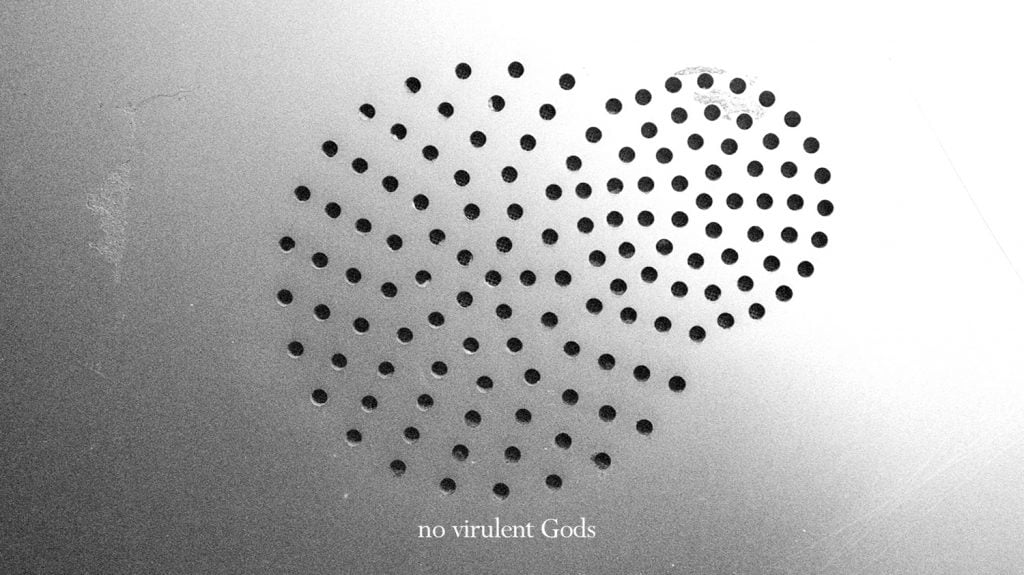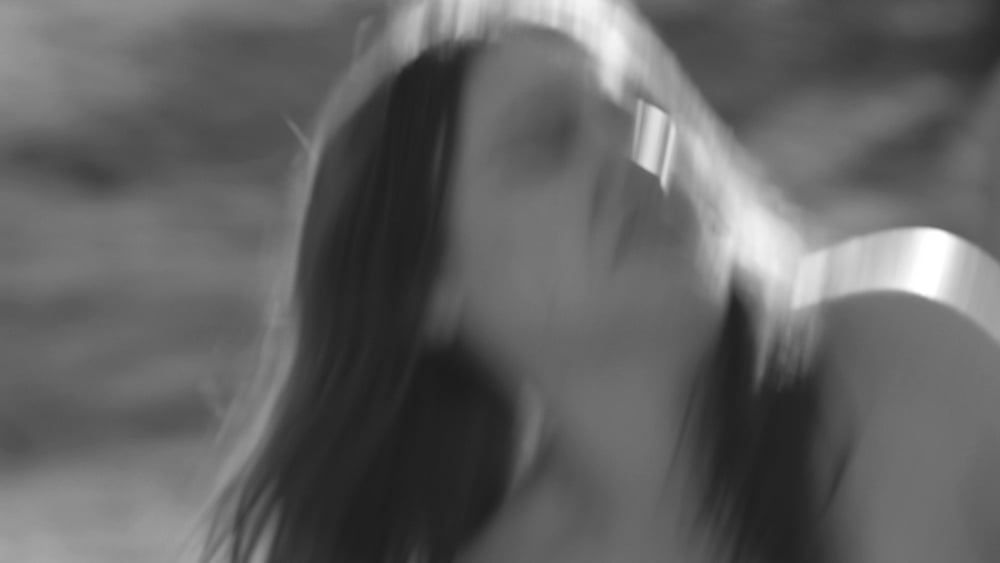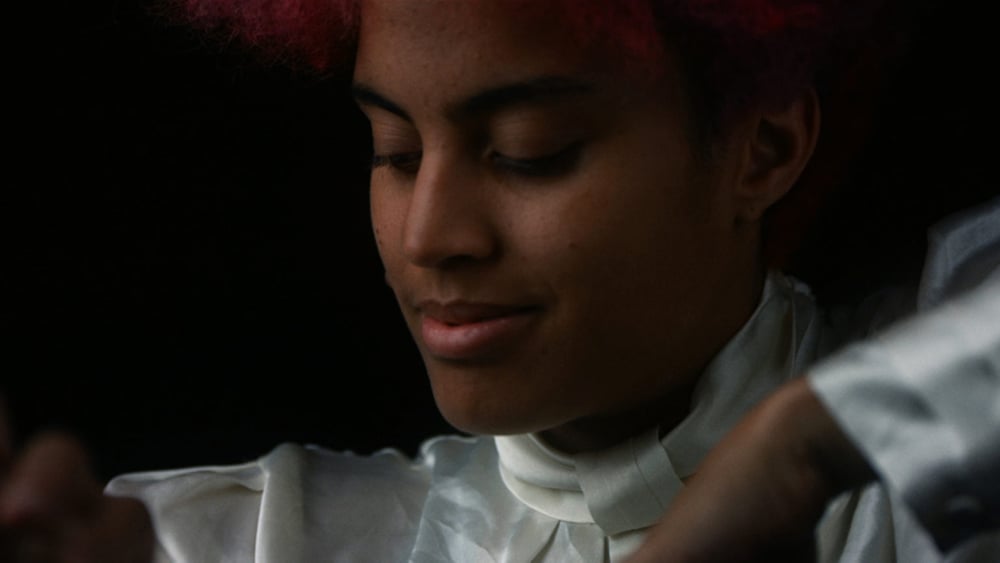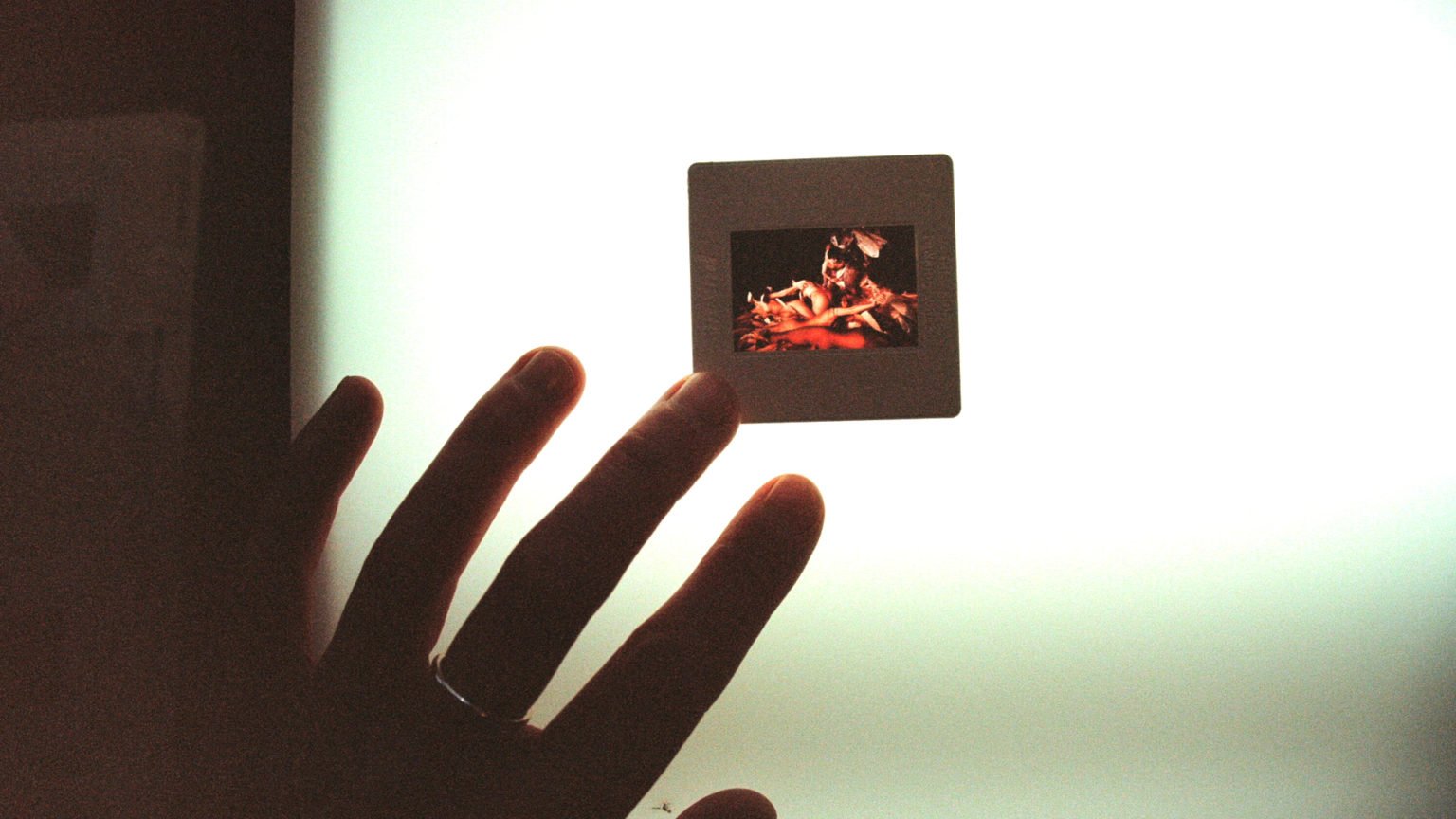Imagine Persephone coming up to the surface of the earth.
She’s done this so many times, no one bothers to check if she’s really back, not even her own mother. Life goes as planned: spring rituals, flowers blossoming, no one notices her. It’s been a few months but maybe years. It could have been entire geological eras – she feels like a rock herself. (No one up there thinks of the Underworld as layers of stone, but that’s obviously all it is. She, of course, could not tell them, their world would crumble.) She has to learn again how to feel the ground, how to bend and smell the flowers, how to be something different from earth: basically, how to be alive.
She tried to call first.
We hear her voice on an interphone, we can see her voice on the interphone. (x comme x, 2017) It is not much of a platform, just a few holes on a man-made device, staring into nothing. It does not have the carrying power of the echo between cliffs, or the weight of a waterfall. She speaks in French. It might be some sort of politeness – not to impose herself as one of theirs, or a distance that feels unbearable in her mother tongue – she’s been a foreigner for too long. Her voice is firm and excited with things from another era. She has a lot to tell. No one listens, in French or any other language. Rocks have memory, but life doesn’t. No one would know who she is, no one would recognize her. Not even geologists or Ancient Greek scholars, who pretend to be buried in the past, but are really just busy living.

x comme x, Keira Greene, 2017.
She has managed to creep to a waterfall. It’s a far more appropriate stage for her apparition. Waterfalls always feel like fissures between two worlds, not unlike how she feels about herself. (Eustatic Drift, 2018) There are other fossils there, some influential creatures that mark shifts in geological formations, icons of geological times. They don’t make her feel less alone, just inadequate – she is trying to come back to life. She has not marked any shifts and hasn’t done anything of importance apart from being responsible for winter, which was not even her own making. She has always been just a helpless tool for her mother and husband. She’d better go into therapy.
She would, presumably, choose movement therapy.

Eustatic Drift, Keira Greene, 2018
Imagine Persephone trying to be alive (or in therapy): a fossil trying to regain a living body. She would do exactly like performer Katye Coe in the film: lying on her back, heavy like a stone on the ground; buttocks in the air – some ill-placed life force trying to project her upwards; her feet tentatively feeling, first the air, then the floor, not yet knowing how to stand, let alone dance. A flat background sound accompanies her effort to the point of discouraging – no heartbeat yet…
***
There is a form of life that tries to find its way to the surface in Keira Greene’s films. A form of being human in relationship to nature, to space, to time, to other humans and other forms of life. A form of being alive.
It is a chronic malaise that reappears in our culture with more force the more it is repressed: the lost continuity and connection with the world and others, the resonance with everything surrounding us.
This immanence in the world is a state that has been attributed to animals, prehistoric men, or infants, but is considered irrevocably lost on modern man. “An animal is in the world, Bataille wrote, like water in water”, separate yet indistinct. A human being (and human consciousness), on the other hand, almost by definition stands in the way of the unity of the world. The human mind divides, resists, attacks, yet humanity made reason its highest ideal. We have come to a point where all human presence in the universe appears superfluous and disruptive. (Think about ecology, or the Anthropocene as the most recent iterations of this self-destructive and self-abasing mode of being.) “If only I knew how to disappear there would be a perfect union of love between God and the earth…” These are the words of Simone Weil who knew all too well the everyday pain of standing in the way of the flow of nature, and dedicated her life to the art of disappearing, subjectively as well as objectively.
How am I alive, is thus not an a-historical question, although both history and life often feel more bearable when rendered in geological terms. There is a specific right-nowness in the question of living, or rather in the way we conceive of what being alive is.
In the interest of pure immanence, Persephone from the Underworld is already alive. Even fossilized, she is part of the unity of nature. The Underworld brings her right into the space of the unconscious, the dream, or death. Yet, once in a while (half of the time according to the legend), she needs to come to the surface, to the superficial world of quarrelling Olympic gods and arrogant humans, a well organized world nonetheless. She suddenly becomes the uncomfortable upright “I” in the way of the flow of nature. An “I” that has to question how to move, how to live. Only then, and from this point of separation, as a human from the upper world, one can ask – what is it to be alive?
In his recent essay addressing the current pandemic, “L’idolâtrie de la vie”, the French mathematician and philosopher Olivier Ray takes a look at the evolution of the very definition of life:
“In the dictionaries of the 17th and 18th centuries, life was defined as “the union of soul and body”. From the end of the 18th century, things change: life becomes “the state of animate beings as far as they have in them the principle of sensations and movement” (Dictionnaire de l’Académie française of 1795), “the state of activity of organised substance” (Littré, 1863), and today “the totality of phenomena and essential functions manifesting from birth to death and characteristic to living beings” (Trésor de la langue française, 1994). All the while that life has been rendered “physiological”, some memories remain of the old meaning. In the background we can hear resonate, even if silenced, the biblical words of God telling Moses: “Choose life”; of Jesus affirming: “I am life”. As a result, the amalgam between the expressed and repressed meaning arrives at this strange thing: the adoration of “the totality of phenomena and essential functions manifesting from birth to death and characteristic to living beings”.[1]
Ray sees in this idealization of physiological life a curious merging between a life of ideals (for which people used to die) and today’s obsession with perpetuating life by controlling bodily functions. The worship of physiological activity as life becomes the legitimation of contemporary governance: a government’s highest goal is to preserve life at all costs. Not some idealized form of living, worth dying for, but the pure totality of physiological functions that makes us technically alive.
However, there is one more thing that strikes in the most recent dictionary entry, and it is the circularity of the argument, a kind of tautology that explains life simply as something pertaining to a living being. While the characteristics of this being are broken down to physiological aspects like functions and phenomena, rather than body and soul, the mystery of life remains untouched. Not only body and soul but also activity, movement and sensations are all taken out of the definition of life. A living being is a tautological being, trapped in performing the unexplained phenomenon of being alive. Could it be that this minutely scientific interpretation in fact clears the field of its anthropocentric focus, to open it to other ways of conceiving the universe and the living? Simpler organisms for instance will appear in this light better adapted to the purpose of life than humans.
****
Imagine Persephone stumbling upon the grounds of the Esalen Institute in California in the 1970s – a place dedicated to exploring and developing the potentials of human consciousness and the connections between body and mind. She descends down a hill observing people engaged in a ball game, slowly coming to realize they are completely naked and the ball imaginary. (In real life it was Keira Greene’s father who found himself in this situation and told the story to his daughter.) (Totally on Fire, 2015) The camera is respectful, not voyeuristic, probably like the eye of Persephone herself. We see bits and pieces of bodies and faces, slowly getting to know each person and their movements – men, women, young, old, fully emerged in the game. In the absence of a real ball, it is their imagination and agreement that keeps the game going (isn’t this almost a metaphor of human life?). But it is not all just in the mind. It is their bodies that make the game real, make the ball real, the connections real. Suddenly, the absence of an external object and purpose turns every action into simple presence. The sound contributes to this augmented feeling of life as well. It is noise – joyfully and liberatingly banal – people chatting on the lawn, oblivious to what they are seeing. It makes the scene we are observing almost disappear in the background and opens the field of vision to a panorama of “phenomena and functions characteristic to living beings”.

Totally on Fire, Keira Greene, 2016
Grain (2016) also takes as a starting point a celebrated phenomenon of the Californian counterculture. This time the film revolves not around humans but around an object – the wooden deck of Mountain Home Studio in California, built in 1952 by environmental architect Lawrence Halprin for his wife, choreographer Anna Halprin.
Halprin is known for her pioneering work as a dancer and choreographer, and for developing together with her husband a system of scores that can be used in the collaborative process across disciplines. However, her most lasting influence has been probably the therapeutic aspect of her work, using dance and performance for healing individuals as well as communities. Halprin famously helped cure her own cancer almost 50 years ago and documented the healing process in a video performance. She is alive to this day at the age of 100. Through her practice Halprin has maintained that we need to stay connected with the natural environment through direct experience.
The deck was the place where Halprin was and is still gathering her students for her workshops, also sometimes the site of the Tamalpa Institute – an institution founded by her daughter and collaborator Daria Halprin. The place gradually became a thing in itself, bearing the memory and energy of evolving dance groups and their sessions. In the film it is mostly Daria Halprin who is speaking, but the voice of the surrounding nature and the physical sense of place are equally strong presences.
Neither Grain nor Totally on Fire are a fetishist revisiting of the counterculture of the 1960s. They are rather renewed experiences, with their own internal and historical truth. There is a particularly sober and distant tone to Greene’s films. Even when approaching topics of spiritual development, there is a scientific measure and clarity in the treatment of the subject, as well as a sense of uncertainty and testing – there is no overarching truth or particular moral to the stories the artist tells. Indeed, behind the scenes of many of her films, Greene collaborates with scientists, with whom she develops long and patient working relationships, where the understanding of a specialized knowledge is let to develop and find its way into the images.
It might appear counterintuitive that films that delve into poetry, myth and the re-enchantment of the world are so indebted to science. However, the help of scientific expertise allows the artist to multiply the perspectives, acknowledging that even science is no absolute truth, only our current state of knowing. This distance gives Greene’s approach a particular sense of time, of presence in the moment in its uncertainty and malleability, a kind of attention that is both in and outside of its object.
***
Persephone’s double life, we’ve been told, is a symbol of the circle of life and death, of the renewal of nature. But we can also see her as someone who constantly goes between the upper world of clarity and reason, and the obscure underworld of not-knowing, of just existing. It is significant that this world outside knowing is considered not-life, equal to death. Socrates, the philosopher of not-knowing, could be our guide here. (“I neither know, nor think that I know”.)
The precept “Know thyself”, written on the temple of Apollo in Delphi, has come to represent a fundamental principle to Western thought since Ancient Greece. “Know thyself” informs our relationship to truth through knowledge and knowledge alone, rather than experience.
In his last lectures, “The Hermeneutics of the Subject”, Michel Foucault remarked that in Hellenistic thought, and in Socrates and Plato in particular, “know thyself” did not have its current, “Cartesian” meaning. Instead, it was always coupled, or even subordinated to another precept, which was: “take care of yourself”. “Know yourself” was almost conditional to the practice of care – a particular type of attention and attitude towards oneself and the world. “To care of oneself” as a moral philosophy was not an abstract thought process; it was a way of behaving in the world, of undertaking actions and relating to others – a practice throughout life. It was in fact a quite precise and demanding activity, which required effort and had its methodology. It involved a set of spiritual practices, many of which have had a long history – including meditation, breathing exercises, memorization of the past, examination of conscience, etc.[2]
Foucault insists on the aspect of self-care as practice. Even as a philosophical principle, the care of the self was a form of activity, If we understand philosophy as addressing the question of “how to have access to truth”, spirituality postulates that the truth is never given to the subject simply by knowledge. In order to have access to truth, the subject has to undertake a transformation and become something “other than himself”. In Antiquity, Foucault claims, these two aspects – the philosophical and the spiritual, knowledge and transformation – were not yet separate. Knowing and care (practice) were two sides of the same coin, “a form of life”.
For Foucault, Socrates’s fundamental job as a philosopher was to teach others to take care of themselves spiritually – Socrates was both a teacher and a sort of therapist. Other thinkers however have gone further, calling Socrates a sorcerer, a healer, or a shaman.[3]
It is interesting that the same notions of therapy, specific attention, practice and transformation of existence, Foucault used to describe the care of the self, another French thinker, Francois Roustang, attributed to the therapeutic practice of hypnosis.
Roustang, a philosopher and a dissident Lacanian, is best known for his apology and practice of hypnosis, as a kind of radical and emancipatory method of subject transformation, distinct from and even opposite to psychoanalysis.[4] Unlike psychoanalysis where the patient is trapped into lamenting and indulging his symptoms, hypnosis should take the patient into the action of changing their own existence, by exercising a specific kind of attention/non-attention. The hypnotized acts from a place on the verge of consciousness, which is not to be understood as the unconscious but rather as a moment of altered consciousness.
Roustang too was compelled by the figure of Socrates and drew numerous parallels between the methods and goals of hypnosis and those of the “shaman-philosopher”: among them are techniques like actively sabotaging reason and searching for a place of “ignorance”, creating confusion, destabilizing habitual thoughts and ways of doing – all with the goal to create a state of “availability for existence”, from which all change and all action is possible.[5] For Roustang (and to a certain extent for Socrates) precisely the practice in which the subject is rendered vulnerable and ultimately subjective to influence, becomes the place from which one can find the impulse to act.[6]
If Socrates, the healer-philosopher can teach us something through his therapeutic practice dressed in words, as philosophy, it is that thought has existence only in action, knowledge requires transformation. The psyche does not exist, insists Roustang, we cannot separate body and soul, subject and object, we partake in the totality of things. Knowing oneself is useless, one must live.
Something Persephone must have known too well.
***
Imagine looking at Persephone. (Folds, 2020) The camera follows her face, the movement is slowed down (using cutting-edge high speed digital camera technology, capable of capturing micro movement) to a point we are not only aware of all the details of her skin and features but also of her three-dimensionality, of her materiality and her actual being in space. There is little we can know and tell about her, other than she exists. She is both human – moving, expressing, interacting with the world, and an object of the world – present, material, observable. She is alive, not in the obvious way of being full of life, but on the plane of confusion between the animate and the inanimate; not a portrait but a panorama of less and less determined phenomena that seem to be pertaining to life. We are alive looking at her, sometimes forgetting what we are looking at, sometimes forgetting what we are while we are looking at her, why not, hypnotized.

Folds, Keira Greene, 2020
[1] Olivier Ray, “L’idolâtrie de la vie”, Collection Tracts, Gallimard, 2020 (Translation DD).
[2] Michel Foucault, The Hermeneutics of the Subject: Lectures at the College de France, 1981-82, New York, Picador, 2005.
[3] Nicolas Grimaldi, Socrate, le sorcier, Paris, PUF, 2004; François Roustang, Le Secret de Socrate pour changer la vie, Paris, Odile Jacob, 2009, among others
[4] Roustang was trained in Ericksonian hypnosis. He was among the first representatives of the renewal of hypnosis in France and its most notable theoretician. François Roustang, Qu’est-ce que l’hypnose, Paris, Les editions de minuit, 1994/2003.
[5] François Roustang, Le Secret de Socrate pour changer la vie, Paris, Odile Jacob, 2009.
[6] Foucault also notes the importance of the teacher or the mentor in the practice of the care of the self in Antiquity.
Dessislava Dimova is a writer and curator based in Sofia, Bulgaria.









